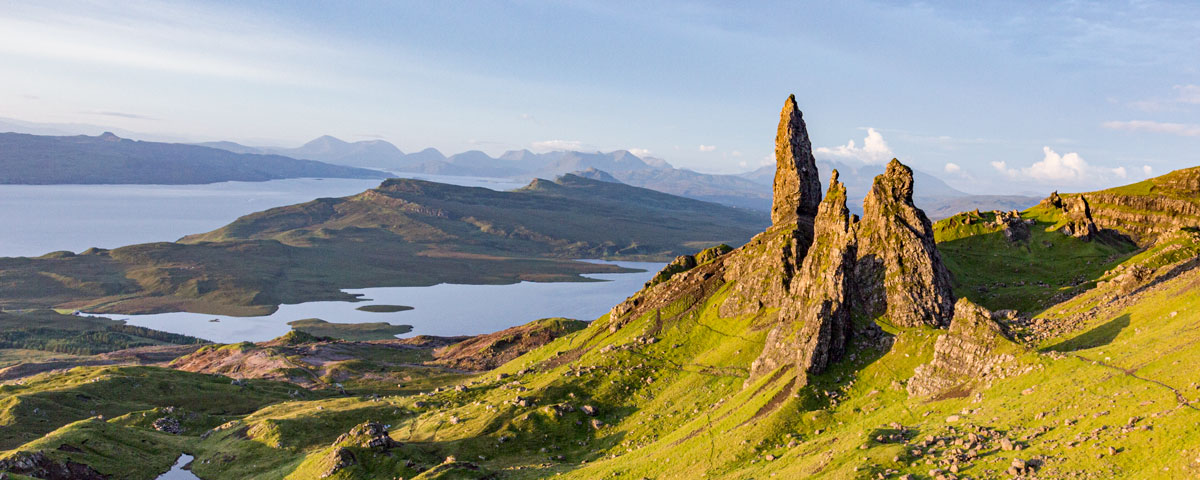Clan MacKinnon | 'Audentes Fortuna Juvat'

Lands and title
The name MacKinnon is said to have come from the Gaelic Mac Fhionguain or Fhionghinn, meaning fair born.
The MacKinnons are said to originate from the son of the 5th century king of Dalriada in Northern Ireland, Loarn mac Eirc. The clan’s progenitor, Finandus, came from one of the seven clans of Siol Alpin, direct descendent of Cinàed MacAilpìn (Kennth MacAlpin) who, in 843, conquered the Picts to become the first king of Scotland.
The original clan lands of the MacKinnons can be traced back to Mull as early as the 9th century. It was not until after supporting King Robert the Bruce to gain victory at Bannockburn in 1314 that they were bestowed lands on Skye, which became their chief residence.
From around 1360, the clan’s main family seat was at Dùn Ringill (fort at the point of the ravine) on the western shores of Loch Slapin near Elgol. It was here they built Castle Findanus on the site of an Iron Age broch. In the mid-1500s, the family moved residence to Kilmarie House and the graveyard of the adjacent derelict Kilmarie church contains the mortal remains of many clan members.
By the mid-16th century, the MacKinnons held the land known today as Strathaird on Skye, as well as Pabay, Scalpay and Mishnish on the Isle of Mull, with the family seat at Dunakin (later Caisteal Maol, English Castle Moil) on the shores of Kyleakin.
Dunakin has been the historic seat of the MacKinnon clan since 1553. The tower was built under the Lordship of the Isles in the 15th century and was destroyed by fire in the early 17th century, after which it became known as Caisteal Maol (the bald or roofless tower).
Dunakin
The fort of King Haakon (Dunakin) is also the site of a broch. Like Kyleakin (strait of King Haakon), the name originates from the Norwegian King Haakon IV who ruled the area until his defeat at the Battle of Largs in 1263.
For centuries, the seanchaidhean (storytellers) told the tale of Saucy Mary, a Norwegian princess who inhabited the castle when Scotland’s western seaboard was under Norse rule. Mary gained her infamous reputation by regulating sea traffic through the narrow straits of Loch Ailse with a chain stretching from the mainland to Skye. By stopping the boats, she was able to command a toll. It was this audacious behaviour that gave her the “saucy” reputation.
Heraldry
The first quarter of the MacKinnon heraldic shield denotes a boar’s head with a deer bone in its mouth. Legend says that once a MacKinnon chieftain was hunting on Loch Scavaig on Skye but lost his hunting party. He spent the night in a cave where he killed a charging wild boar with his dinner (the leg bone from the deer he was eating).
The fourth quarter of the shield shows the hand of the Saint holding a cross. This is a connection to the Abbacy of Iona where Eoin MacFhionghain, Benedictine Abbot of Iona, was buried in 1498. A sculpture of his Celtic Cross in the abbey is known as MacKinnon’s Cross.
Warriors
Like many of the Highland clans, the MacKinnons have a long history of warfare. Under the leadership of the 28th clan chieftain Lachlan Mòr (b. circa 1638), they sided with the MacLeans against the MacDonalds during a bitter clan feud in the late 16th century.
In the mid-17th century, these staunch supporters of the Stuarts, aided Charles I against Cromwell’s armies in the British Civil wars by raising a regiment behind the standard of the Marquess of Montrose in 1645. Clansmen fought in the Battles of Aulder and Inverlochy; as well as Worcester in 1651, when Lachlan was said to have saved the life of King Charles II.
Together with the MacDonald’s of Sleat, the MacKinnons fought for Scotland’s sovereignty by supporting the Jacobite uprisings of 1715 and 1745 to take up arms against the British throne in favour of the “true” king, Charles III. It is said the chieftain Iain Dùbh aided Bonnie Prince Charlie in his flight from the battlefields of Culloden by hiding him in a cave on Skye and delivering him food and water. Iain stole the prince away by boat to Loch nam Uamh on the mainland from where the Bonnie Prince managed to escape to France.
MacKinnons today
The Clan Chief’s insurgency during the ’45 Rebellion led to his arrest by the British Government. After a year’s imprisonment, he was freed but his lands were made forfeit, after which time the MacKinnons became landless.
The last chieftain of the direct line to Lachlan Mòr died without issue in 1808 and, Charles, the great-grandson of Lachlan’s second son, became the 33rd MacKinnon chief in that year. He sold what was left of the MacKinnon estate in 1791. The Highland Clearances would later evict families from their ancestral homes and scatter them across the seas to find refuge in the New World.
The current title is held by Madam Anne Gunhild MacKinnon of MacKinnon 38th Chief of the Name and Arms of MacKinnon. She lives in Somerset, England
Motto: Audentes Fortuna Juvat (Fortune assists the daring)
Slogan: Cuimhnich bàs Alpein (Remember the death of Alpin)
Crest: Quarterly, 1st, Vert, a boar’s head, couped, holding in the mouth a shin-bone, Argent; 2nd, Azure, a tower, triple-towered, Argent; 3rd, Or, a lymphad, Gules; 4th, Argent, a man’s arm, couped below the wrist, from the sinister, Proper, grasping a cross crosslet fitchée, Sable
Clan septs: Love, MacKinning, MacKinney, MacMorran, Mackinven
Chief Mac Fhionghain: Madam Anne Gunhild MacKinnon of MacKinnon 38th Chief of the Name and Arms of MacKinnon.
Historic seat: Caisteal Maol (Castle Moil), Kyleakin.

